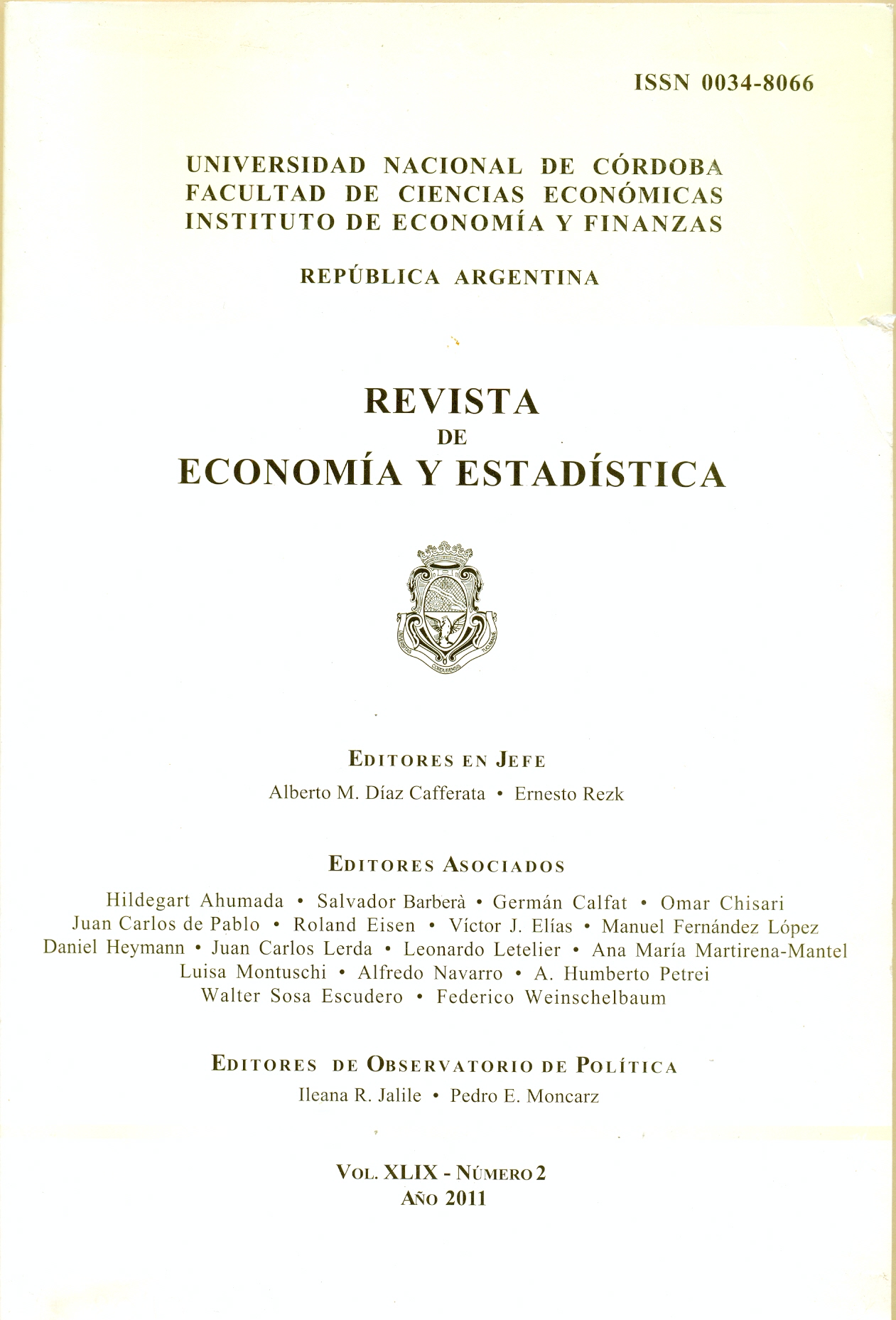Should Latin American countries adopt structural balance-based fiscal rules?
DOI:
https://doi.org/10.55444/2451.7321.2011.v49.n2.7492Keywords:
fiscal rules , Latin America, structural fiscal policy, procyclicalityAbstract
Latin America has a long history of pro-cyclical fiscal policies, reflecting the region’s exposure to a range of exogenous shocks, tight financial constraints and relatively weak fiscal institutions. This paper discusses the role that structural balance-based fiscal rules (SFRs) could play in moderating pro-cyclicality, ensuring longer-term debt sustainability, and facilitating the coordination of fiscal with other macro-economic policies in the region. It also focuses on the necessary ingredients for a sound design and successful implementation of SFRs. The fact that these conditions are rather demanding, and unlikely to be adequately fulfilled in many Latin America countries at the present time, suggests that a gradualist approach may be more realistic, beginning with a systematic and transparent calculation and dissemination by the authorities of structural indicators to assess the fiscal stance and inform budgetary policy, and moving to more formal rules over time as the relevant pre-conditions are put in place.
Downloads
References
Alesina, A., Hausmann, R., Hommes, R.and Stein, E (1996). “Budget Institutions and Fiscal Performance in Latin America”, IADB Working Paper No.394.
Balassone, F. and Kumar, M. S. (2007). “Cyclicality of Fiscal Policy,” in Ter-Minassian, T. and Kumar, M. S. (eds.) Promoting Fiscal Discipline, pp. 19–35 (Washington, DC: International Monetary Fund).
Barnett, S. and Ossowski, R. (2003), “Operational Aspects of Fiscal Policy in Oil-Producing Countries” , in: Davis, J.M., Ossowski, R. and Fedelino, A. (eds.) Fiscal Policy Formulation and Implementation in Oil-Producing Countries, pp.45-81 (Washington, DC: International Monetary Fund).
Barnett, S. and Vivanco, A. (2003), “Statistical Properties of Oil Prices: Implications for Calculating Oil Wealth”, in : Davis, J.M., Ossowski, R. and Fedelino, A. (eds.) Fiscal Policy Formulation and Implementation in Oil-Producing Countries pp.45-81 (Washington, DC: International Monetary Fund).
Corbo, V. and others, (2011). “Propuestas para Perfeccionar la Regla Fiscal”, Informe Final del Comité Asesor para el Diseño de una Política Fiscal de Balance Estructural de Segunda Generación para Chile, Santiago, Chile.
Daude, C., Melguizo, A. and Neut, A. (2010). “Fiscal Policy in Latin America: Counter-cyclical and Sustainable at Last?”, OECD Development Center Working Paper no. 291, Paris, France.
Debrun, X., Hauner, D., and Kumar, M. S. (2009). “Independent Fiscal Agencies,” Journal of Economic Surveys, Vol. 23, No. 1, pp. 44–81.
DIPRES (2005). "Informe de Finanzas Públicas: Proyecto de Ley de Presupuesto del Sector Público para el año 2006", Dirección de Presupuestos del Ministerio de Hacienda, Santiago de Chile.
European Commission (2010). Public Finance Report in EMU-2010, European Economy 4/2010.
Fedelino, A. Ivanova, A, and Horton, M. (2009). “Computing Cyclically Adjusted Balances and Automatic Stabilizers”, IMF Technical Notes an Manuals.
Girouard, N. and André, C. (2005). “Measuring Cyclically-Adjusted Budget Balances for OECD Countries”, Department Working Papers, No. 434, OECD, Paris, France.
Hagemann, R. (2010), "Improving fiscal performance through fiscal councils", Economics Department Working Papers, No. 829, OECD, Paris, France.
Kopits, G. (2004), “Overview of Fiscal Policy Rules in Emerging Markets” in: Kopits, G. (ed.) Rules-Based Fiscal Policy in Emerging Markets. Background, Analysis, and Prospects, pp. 1–11 (Palgrave).
Kyobe A. and Danninger S. (2005). “Revenue Forecasting--How is it done? Results from a Survey of Low-Income Countries”, IMF Working Papers 05/24, International Monetary Fund.
Larch, M, and Turrini, A. (2009).“The Cyclically-Adjusted Budget Balance in EU Fiscal Policy Making: A Love at First Sight Turned into a Mature Relationship,” European Economy-Economic Papers No. 374.
Larrain, F. (2008). “Chile Menos Volatil?”, El Trimestre Economico No.299, July-Sept.2008
Lefort, G. (2006). “Politica Fiscal con Meta Estructural en Experiencia Chilena” Ppt. presented at the Second Annual Meeting of the LAC Debt Group in Cartagena, Colombia
Maliszewski, W. (2009). “Fiscal Policy Rules for Oil-Producing Countries: A Welfare-Based Assessment” IMF Working Paper WP/09/126
Marcel, M. (2009), “La Regla de Balance Estructural en Chile: Diez Años, Diez Lecciones”, mimeo
Perry, G., Serven, L. and Suescun, R. (2008). “Fiscal Policy, Stabilization and Growth”, Washington, DC, The World Bank
Stein, E., Talvi, E. and Grisanti, A. (1998). “Institutional Arrangements and Fiscal Performance: the Latin American Experience” NBER Working Paper no. 6358, Cambridge, MA, NBER
Sutherland, D., Price, R. and Joumard, I. (2005). “Fiscal Rules for Sub-central Levels of Government: Design and Impact”, OECD Economics Department Working Paper No.465
Ter-Minassian, T. and Fedelino, A. (2010). “Impact of the Global Crisis on Sub- national Governments’ Finances” in IEB: Fiscal Federalism Report (Barcelona, Spain)
Ter-Minassian, T. (2011). “Main Fiscal Challenges for Brazil”. In CESifo Economic Forum, no.1, Munich, Germany
Villafuerte, M., Lopez-Murphy, P. and Ossowski, R. (2010). “Riding the Roller Coaster: Fiscal Policies of Nonrenewable Resource Exporters in Latin America and the Caribbean”, IMF Working Paper 10/251, Washington, DC.
Downloads
Published
How to Cite
Issue
Section
License
Copyright (c) 2011 Teresa Ter-Minassian

This work is licensed under a Creative Commons Attribution-NonCommercial-NoDerivatives 4.0 International License.
Authors who have publications with this journal agree to the following terms:
Authors retain their copyright and grant the journal the right of first publication of their work, which is simultaneously subject to the Creative Commons Attribution-NonCommercial-NoDerivatives 4.0 International License that allows third parties to share the work provided that its author and first publication in this journal are indicated.
Authors may adopt other non-exclusive licensing arrangements for distribution of the published version of the work (e.g. depositing it in an institutional telematic archive or publishing it in a monographic volume) as long as the initial publication in this journal is indicated.
Authors are allowed and encouraged to disseminate their work via the Internet (e.g. in institutional telematic archives or on their website) before and during the submission process, which can lead to interesting exchanges and increase citations of the published work. (See The Open Access Effect)









